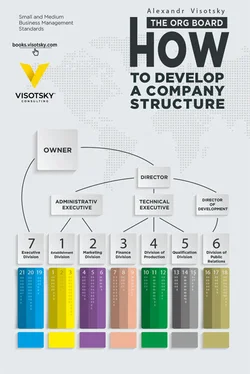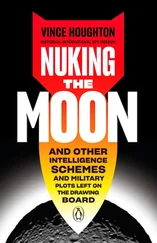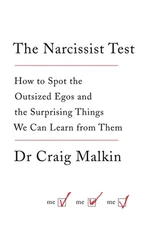Александр Высоцкий - The org board. How to develop a company structure
Здесь есть возможность читать онлайн «Александр Высоцкий - The org board. How to develop a company structure» — ознакомительный отрывок электронной книги совершенно бесплатно, а после прочтения отрывка купить полную версию. В некоторых случаях можно слушать аудио, скачать через торрент в формате fb2 и присутствует краткое содержание. Жанр: small_business, management, paper_work, на русском языке. Описание произведения, (предисловие) а так же отзывы посетителей доступны на портале библиотеки ЛибКат.
- Название:The org board. How to develop a company structure
- Автор:
- Жанр:
- Год:неизвестен
- ISBN:нет данных
- Рейтинг книги:5 / 5. Голосов: 1
-
Избранное:Добавить в избранное
- Отзывы:
-
Ваша оценка:
- 100
- 1
- 2
- 3
- 4
- 5
The org board. How to develop a company structure: краткое содержание, описание и аннотация
Предлагаем к чтению аннотацию, описание, краткое содержание или предисловие (зависит от того, что написал сам автор книги «The org board. How to develop a company structure»). Если вы не нашли необходимую информацию о книге — напишите в комментариях, мы постараемся отыскать её.
The org board. How to develop a company structure — читать онлайн ознакомительный отрывок
Ниже представлен текст книги, разбитый по страницам. Система сохранения места последней прочитанной страницы, позволяет с удобством читать онлайн бесплатно книгу «The org board. How to develop a company structure», без необходимости каждый раз заново искать на чём Вы остановились. Поставьте закладку, и сможете в любой момент перейти на страницу, на которой закончили чтение.
Интервал:
Закладка:
CEOs of smaller companies come to a seemingly logical conclusion that the drop is due to the incompetence of his new hires or their unwillingness to work. Have you ever heard executives complain about employees who don't want to work? Yet, these same employees had previously produced good results under direct management – and suddenly everything changed.
The real reason is not that people transform overnight, but that the leader- usually, the owner of the company – is only good at directly managing rank and file employees and not his new level of executives. The owner knows the production technology and competently directly guides employees to the desired results. The owner is just not able to effectively manage the executives who must now manage the other employees. It's one thing to fly a plane, which in itself is not an easy task and requires special skills, but it’s a completely different job to lead a team of pilots. A pilot has to competently handle the machine, an executive needs to competently handle people. Additionally, they use completely different bodies of knowledge and tools.
This is the main reason why small and profitable companies, even those with great products, rarely expand beyond a certain point. They weren’t able to overcome the First Management Crisis and grow out of their small business "pants". Thousands of examples illustrate the First Management Crisis. One of the most famous is the incredibly successful small family restaurant owned by brothers Dick and Mac McDonald. It was well known locally and produced a steady income for its owners. The brothers made numerous attempts to create a network of fast food restaurants, but it wasn’t until Ray Kroc [1] Ray Kroc: Raymond Albert "Ray" Kroc (October 5, 1902 – January 14, 1984), an American entrepreneur, restaurateur and owner of McDonald's corporation. He was included by Time magazine in the "100 most important people of the century" list. He amassed a fortune valued at $500 million at the time of his death.
took on the business development that McDonald’s was born.
A lesser known, but no less illustrative example is that of the famous Brooklyn pizzeria Di Fara Pizza who has had the same owner and chef, Domenico DeMarco [2] Domenico DeMarco: the founder and chef at Di Fara Pizza, a pizzeria in Brooklyn, a borough of New York City. The facility opened in 1964. The New York Times called the restaurant: "one of the most acclaimed and sought-after pizza shops in New York City". This pizzeria is known for its great tasting pizza, noted by New York magazine, online publication Serious Eats, Zagat rating company, and Frommer's travel guides.
, since 1964.
Experts have repeatedly honored DeMarco’s pizza with the highest awards. Yet, despite the outstanding taste and a long line of people outside the restaurant, the facility has not expanded since its opening. Of course, this situation greatly depends on the goals of the business founder. In this example the owner simply doesn’t desire to expand his business. His passion lies in the craft and it seems that he simply likes making pizza without any further ambitions. To get to the next stage of business development, one needs to have the ambition to grow and have big goals. Then there is a chance to overcome this crisis. In my book, The Business Owner Defined, I described, in detail, the objectives of a business. However, to become successful, it is not enough to just have goals for the company executives. There has to be tools, such as a company structure, a system to measure results, financial policies, etc.
A business falls into the First Management Crisis after appointing executives without any management tools. These executives expect the owner to utilize the same hands-on control, but in a more difficult condition as the company has grown. Additionally, the owner now tries to manage "manually" at a new level, which is usually unsuccessful, and so the chaos grows. In order to overcome the crisis, the founder of the company must master the tools for managing people, train strong leaders, and learn to manage effectively.
Once the first crisis is handled, the company will continue to grow and that may continue for many years. But interestingly enough, sooner or later the founder of the company will feel the need to switch out managing the daily operations for carrying out strategic management while remaining the goal setter.
To win a large-scale battle, one needs to be on an elevated plane where they can view the whole battlefield and the surrounding area. Therefore, can properly plan one’s own actions and anticipate the actions of the enemy. It is impossible to intelligently manage a large-scale activity being in the thick of things at the forefront. The second management crisis has to do with the inevitable need to take on the functions of a strategist to direct the activities of a well-organized company. The owner must go from operational management to strategic.
Often it is the desire to move away from daily operations (the front of the battle) that encourages owners to implement management tools. However, one needs to realize that simply adding an organizing board and other tools will not facilitate the switch on their own; they will only create the necessary foundation. After you implement the management tools, you need to cultivate competent executives, and only then can you delegate the management of operations. If you go about this with an intelligent plan, you could implement management tools in a small business in six months to a year, and cultivate your executives within a year. This is a big job. You will have to invest as much time and effort as you would in establishing your technological processes. But the game is worth your while – the company will not only become well-managed, it will also gain a significant advantage over its competition.
Chapter 2
Valuable final product
The Valuable Final Product (abbreviated to VFP) is one of the key management concepts defined by L. Ron Hubbard in his articles. You see this all the time – your employees perform lots of actions, but not all of them are actually directed towards results. Or you see how someone is always preparing to do a job: he arranges his papers, organizes the computer files, he invents clever ways to organize his desk tools, etc. Another employee is running around crazed and completing one thing after the other. He may look busy, but he’s still not producing the results you expected. Why is this happening? Why do we have those who produce results and those who are busy with "doingness"?
In the dictionary, we can find the following definition for product, "an artifact that has been created by someone or some process" where artifact is “a man-made object taken as a whole”. An accountant prepares a report and sends it to the IRS, that is definitely a product. When a barista puts the final touches on a cup of coffee and hands it to the customer – that is also a product. When the owner of a company develops a strategy, by spending his time and energy on it, and describes it in a document that can then be studied by his executives – the strategy here is a product.
Note that the word object means “a tangible and visible entity”, where tangible means that it can be perceived by the senses as something that exists. Therefore, somebody’s brilliant plan that is not shared with anyone is not a product because other people cannot perceive it, unless they are able to read the person’s mind. For that plan to become a product, it has to be at least shared with someone, and then it will become a product. The product is always tangible, even when it comes to such "intangible" things as designs, plans, and ideas. They need to be described on paper or introduced during presentations – otherwise they are not products. A motivational meeting that inspires employees to succeed is a great product for an executive, as the change in employee attitude is quite tangible – you can see and feel it. But the product that is not noticeable to others, by definition, cannot be a product. If the, "I was trying”, “I attempted to”, “I was getting ready to”, etc don’t result into something that can be perceived by the senses, it’s not a product.
Читать дальшеИнтервал:
Закладка:
Похожие книги на «The org board. How to develop a company structure»
Представляем Вашему вниманию похожие книги на «The org board. How to develop a company structure» списком для выбора. Мы отобрали схожую по названию и смыслу литературу в надежде предоставить читателям больше вариантов отыскать новые, интересные, ещё непрочитанные произведения.
Обсуждение, отзывы о книге «The org board. How to develop a company structure» и просто собственные мнения читателей. Оставьте ваши комментарии, напишите, что Вы думаете о произведении, его смысле или главных героях. Укажите что конкретно понравилось, а что нет, и почему Вы так считаете.












